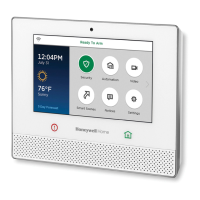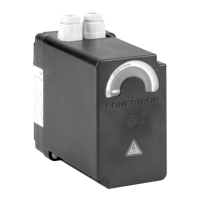Do you have a question about the Honeywell LCBS and is the answer not in the manual?
Ensures comfort by scheduling and managing building occupancy for energy savings.
Provides three stages of heating/cooling for conventional and heat pump systems.
Supports nine strategies for using outdoor air to cool building spaces.
Details how schedules manage occupancy for comfort and energy efficiency using Adaptive Intelligent Recovery.
Explains objectives for heating, protecting equipment, and efficient operation.
Covers heat pump mechanics, reversing valve control, and types of heat pumps.
Describes heat pump performance variations and comfort vs. energy saving modes.
Ensures discharge air temperature does not exceed a set limit to protect the unit.
Outlines objectives for cooling, protecting equipment, and efficient operation.
Explains problems caused by high humidity and LCBS Connect's dehumidification strategies.
Details methods for dehumidification: reheat, direct output, and extended cooling runtime.
Focuses on using outdoor air for ventilation and cooling, and economizer system components.
Describes three high-level strategies for controlling economizer functions.
Explains mixed air and high limit control loops for integrated economizer functions.
Discusses economizer strategies applicable to different U.S. climate zones.
Utilizes enthalpy and dry bulb temperature for economizer control in all climate zones.
Employs outdoor air enthalpy for economizer control, simple to deploy across zones.
Uses differential temperature between outdoor and return air for control.
Controls economizer based on outdoor air temperature relative to set points.
Overrides economizer damper position to prevent low temperature conditions.
Provides redundant control to shut down system if freezing conditions are detected.
Summarizes available ASHRAE Complete economizer control options.
Explains proportional control, error, set point, and the concept of throttling range.
Determines output setting based on proportional error and throttling range.
Explains set point and differential relationships for on/off and digital control.
Discusses using CO2 sensors to dynamically adjust ventilation rates for energy savings.
Explains DCV operation, CO2 levels, and their impact on ventilation requirements.
Explains how DCV uses CO2 sensing to dynamically adjust ventilation rates.
Covers fan types, variable airflow design, and energy savings from speed variation.
Details methods for controlling fan speed: VFD, two-speed motors, and ECM motors.
Explains control of two-speed motors using discrete fan outputs.
Covers VFD application for changing fan frequency and speed.
Details how LCBS Connect controls VFDs and ECM motors for fan speed.
Explains how LCBS Connect accessory loops control various electrical equipment.
Illustrates controlling a heating blower coil with occupancy schedules.
Shows controlling outdoor lighting using a photo sensor.
Summarizes the capabilities and planning needed for accessory loop control.
Explains how sensors trigger alerts and the importance of selecting specific alerts.
Alerts for mismatch between equipment capacity and space demand.
Monitors space humidity levels to indicate potential cooling system issues.
Alerts for high CO2 levels indicating potential ventilation issues.
Detects filter loading via pressure drop to indicate maintenance needs.
Lists configurable and fixed input/output points for the LCBS Connect controller.
Provides an overview of all master application wiring diagrams.
Illustrates configurable input/output assignments for the LCBS controller.
Ensures comfort by scheduling and managing building occupancy for energy savings.
Provides three stages of heating/cooling for conventional and heat pump systems.
Supports nine strategies for using outdoor air to cool building spaces.
Details how schedules manage occupancy for comfort and energy efficiency using Adaptive Intelligent Recovery.
Explains objectives for heating, protecting equipment, and efficient operation.
Covers heat pump mechanics, reversing valve control, and types of heat pumps.
Describes heat pump performance variations and comfort vs. energy saving modes.
Ensures discharge air temperature does not exceed a set limit to protect the unit.
Outlines objectives for cooling, protecting equipment, and efficient operation.
Explains problems caused by high humidity and LCBS Connect's dehumidification strategies.
Details methods for dehumidification: reheat, direct output, and extended cooling runtime.
Focuses on using outdoor air for ventilation and cooling, and economizer system components.
Describes three high-level strategies for controlling economizer functions.
Explains mixed air and high limit control loops for integrated economizer functions.
Discusses economizer strategies applicable to different U.S. climate zones.
Utilizes enthalpy and dry bulb temperature for economizer control in all climate zones.
Employs outdoor air enthalpy for economizer control, simple to deploy across zones.
Uses differential temperature between outdoor and return air for control.
Controls economizer based on outdoor air temperature relative to set points.
Overrides economizer damper position to prevent low temperature conditions.
Provides redundant control to shut down system if freezing conditions are detected.
Summarizes available ASHRAE Complete economizer control options.
Explains proportional control, error, set point, and the concept of throttling range.
Determines output setting based on proportional error and throttling range.
Explains set point and differential relationships for on/off and digital control.
Discusses using CO2 sensors to dynamically adjust ventilation rates for energy savings.
Explains DCV operation, CO2 levels, and their impact on ventilation requirements.
Explains how DCV uses CO2 sensing to dynamically adjust ventilation rates.
Covers fan types, variable airflow design, and energy savings from speed variation.
Details methods for controlling fan speed: VFD, two-speed motors, and ECM motors.
Explains control of two-speed motors using discrete fan outputs.
Covers VFD application for changing fan frequency and speed.
Details how LCBS Connect controls VFDs and ECM motors for fan speed.
Explains how LCBS Connect accessory loops control various electrical equipment.
Illustrates controlling a heating blower coil with occupancy schedules.
Shows controlling outdoor lighting using a photo sensor.
Summarizes the capabilities and planning needed for accessory loop control.
Explains how sensors trigger alerts and the importance of selecting specific alerts.
Alerts for mismatch between equipment capacity and space demand.
Monitors space humidity levels to indicate potential cooling system issues.
Alerts for high CO2 levels indicating potential ventilation issues.
Detects filter loading via pressure drop to indicate maintenance needs.
Lists configurable and fixed input/output points for the LCBS Connect controller.
Provides an overview of all master application wiring diagrams.
Illustrates configurable input/output assignments for the LCBS controller.
| Frequency | 50/60 Hz |
|---|---|
| Application | Industrial burners |
| Safety Standard | EN 298 |
| Flame Detection | UV |
| Operating Temperature | -20 to +60 °C |
| Humidity Range | Max. 95% r.H. |
| Communication Protocol | Modbus RTU |












